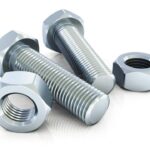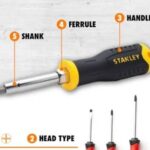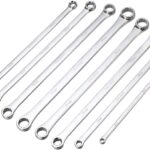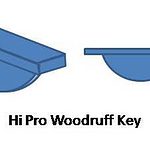Today we will discuss screw thread terminology and types of threads which are used in industries. The treads are used on a cylindrical shaped surface and used as the fasteners. Threaded fasteners are commonly used in all industries and are very popular. A threaded joint is much stronger and removable than the unthreaded joints like rivets. One big benefit of use threaded joint is that the threaded joint can be disassembled when you need easily by using spanners or screw drivers. So this is more popular in industries. The threaded fasteners are available in many sizes and are cost efficient compare to unthreaded fasteners.
Terminology of Threads:
1. Axis of a thread:
This is imaginary line passes through the center and parallel to the length of bolt or nut.
2. Crest:
It is the top most surface of the thread where the two flank meets.
3. Root :
It is the bottom of the groove between where the two flank meets.
4. Flank:
it is the straight plane connects crest with root.
image source : http://www.keystonethreaded.com/common-terminology.html
5. Pitch:
The distance measured parallel to the axis from one point of thread to the corresponding points on adjacent thread known as pitch.
6. Depth of thread:
Distance between the crest and root of the thread.
7. Major diameter:
It is the largest diameter of threads which passes from the crest of thread.
8. Minor diameter:
it is the smallest diameter of which passes form the root of threads.
9. Pitch diameter:
It is a theoretical diameter between the major and minor diameter which is in perfectly rolling action.
According to uses and shapes, there are many types of thread used in industries.
Types of Thread:
According to Shapes:
1. British Standard Whitworth:
It is special type of thread used in screwed fasting. It is symmetrical V thread. The angle between flanks is 55 degree.
2. British Association Thread:
It is BSW thread with fine pitch. It has 47.5 degree flank angle and used in instrumentation works.
3. American Standard Thread:
This thread is also known as US special thread. It has 60 degree flank angle and used for general purpose.
4. Square Thread:
This thread is used for its high efficiency. It has flat creast and root. It is used in power transmission and mostly found on feed mechanism of machine, valves, screw jack. This threads offer less frictional resistance than BSW threads.
5. Acme Thread:
It is modified form of square thread. It has trapezoidal cross
section. It is stronger than square thread and used in lathe, valve and bench
vise.
section. It is stronger than square thread and used in lathe, valve and bench
vise.
6. Knuckle Thread:
It is also modified form of square thread. It has round creast and root and used in railway carriage couplings.
7. Buttress Thread:
These threads are used for power transmission in one direction. It has same strength than V thread and low friction resistance.
8. Metric Thread:
It is an Indian standard thread. It is same as BSW thread instead it has 60 degree flank angle rather 55 degree.
According to position
1. Internal thread :
Thread used on inside surface area such as on nut known as external threads.
2. External thread:
Thread used on outside surface area such as on bolt known as external threads.
Thread used on outside surface area such as on bolt known as external threads.
Today we have discussed about types of screw threads and terminology used in threads. If you have any query, put it in comment box. Subscribe our website for more informative articles. Thanks for reading it.











What is difference between American standard thread and metric thread.
this is very important and very well a lot of thanks bee happy God helps uu every time bechause this is the very simply and well to understand